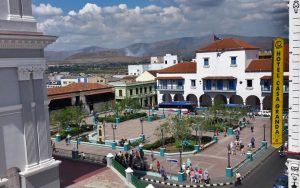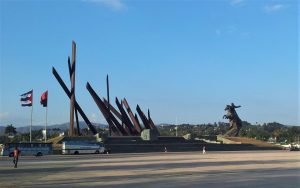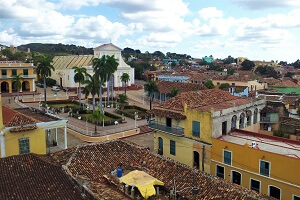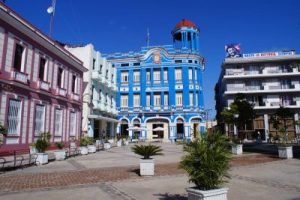Santiago de Cuba

Updated: Dec 19, 2022
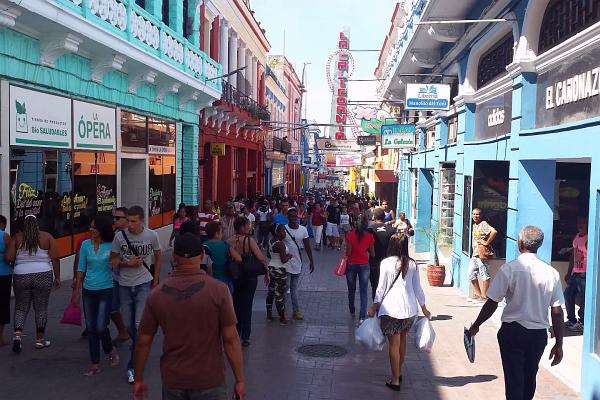
Updated: Dec 19, 2022
Over half a million inhabitants make Santiago de Cuba the second-largest city on the island. With more than five centuries of history, the City belongs to the oldest in Cuba, that has been a melting pot of African, French and Spanish cultures over centuries. Maybe it was to this, that the city became not only the starting point of the Cuban Independence War, but as well of the Cuban Revolution. Because of this history, Santiago is nowadays known as the city of the revolutionaries.
Surrounded by the majestic mountains of the Sierra Maestra, deep in the east of Cuba, much closer to Haiti and Jamaica than to Havana, lies Santiago de Cuba. Like many other cities in Cuba, Santiago was built as a port city situated at a large natural bay.
Santiago is a city with over five centuries of history
Santiago gained increasing importance already shortly after its founding in 1515. Already in 1522 it became the second capital of Cuba, after Baracoa. The harbor was in the early days not only the most important in Cuba, but it was also the main hub for the trade of slaves in the New World. But already after a few decades the city gradually lost its importance and had to hand over its capital status to Havana as early as 1607.
Today, the city is difficult to compare with Havana. Santiago is not only much smaller, but also significantly less urban and international. While Havana has a big city flair, Santiago is more leisurely. Often there is little movement in the hilly streets. In the center there are far fewer visitors to find as in Havana.
While in Havana work on new luxury hotels is going on around the clock, in Santiago horse-drawn carriages continue to rumble through the city center, providing a regular mode of transport.
The Santiagueros, the inhabitants of the city
In addition to its coziness, the city has a very special atmosphere, which is partly due to the fact that a large part of the population is of African descent. The African culture finds expression in the music as well as in the famous carnival, which is Cuba's most important folk festival. Only at the time of the carnival, which is held during the hot summer, the tranquility is gone for a week.
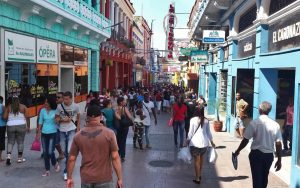 Besides the Santiagueros, as the inhabitants of the city are called, distinguishes the city also a unique location in the midst of the impressive landscape. From the narrow, winding and steep streets, there are many wonderful views to enjoy. Something particular is also the vital pedestrian zone, which extends from the port over a distance of one kilometer through the entire city center. The pedestrian zone is the most important promenade of the city.
Besides the Santiagueros, as the inhabitants of the city are called, distinguishes the city also a unique location in the midst of the impressive landscape. From the narrow, winding and steep streets, there are many wonderful views to enjoy. Something particular is also the vital pedestrian zone, which extends from the port over a distance of one kilometer through the entire city center. The pedestrian zone is the most important promenade of the city.
­
Sights
The most important tourist attractions are located within the city center, between Plaza de Marte and the waterfront. Well worth seeing are also the historically relevant Moncada Barracks and the upscale residential neighborhood of Vista Alegre, the Morro Fortress and the Santa Ifigenia Cemetery. There are also a number of interesting museums to visit. The following overview gives an overview of the main highlights and sights of the city.
Highlights
- Named after the first Cuban president Carlos Manuel de Céspedes, the Parque Céspedes is the most important square in Santiago, that can be defined as the city center. In the center, a monument reminds the name giver, who is considered one of the founders of the independence movement of Cuba as well as the abolition of slavery. Since wireless Internet has been available in the square, the park is also very popular with locals.
- Not far from Parque Céspedes lies the Plaza de Dolores. The green square is a popular gathering place. A monument reminds of the once wealthiest plantation owner in Cuba, Francisco Vicente Aguilera, who was committed to gaining independence from Spain. The young Fidel as well as his younger brother Raul Castro went to school in the bordering Colegio de Dolores.
- At the eastern end of the pedestrian zone there is the Plaza de Marte. This square was built at the end of the 18th century as a parade ground for the Spanish military. Today the square functions as an important traffic hub of the center. From here, buses and shared cabs run in different directions.
- The Morro, or Castillo de San Pedro de la Roca, is located a around 10 km from the city center. It towers impressively above the narrow entrance to Santiago Bay. The fortress was declared a World Heritage Site by UNESCO. It offers a beautiful view of the Caribbean Sea and the mountains of the Sierra Maestra. If you come around late afternoon, you are able to witness an unforgettable sunset. Cab from the city costs around 20 CUC, depending on how long you want to stay. There is also a guarded parking lot (2 USD). Admission to the Morro, which houses a small pirate museum, is 4 USD. Outside the complex there are various stands selling souvenirs. The restaurant offers quite good food by Cuban standards. The prices are moderate ( starting at 5 USD), the view is absolutely outstanding.
- The Cementerio Santa Ifigenia is one of the most beautiful cemeteries in Cuba, and with about 8000 graves also one of the biggest. A visit to the cemetery is like a walk through 150 years of Cuban history, surrounded by a sea of white marble. Many important citizens are buried here. The imposing mausoleum of national hero José Martí is constantly guarded by soldiers. The cemetery also houses the graves of Carlos Manuel de Céspedes, Emilio Bacardí and, more recently, the simple tomb of Fidel Castro. The admission is 3 USD (photography 5 USD extra). A cab from the city center, should cost around 10 USD return.
Museums & Expositions
- The Moncada Barracks are an important site of the Cuban Revolution. Ninety-five fighters led by Fidel Castro attacked the barracks on July 26, 1953. The attack failed. Most of the revolutionaries were killed. Fidel Castro survived and was put on trial. This event is the origin of the 26th of July Movement, which is ubiquitous in Cuba. Today, the site houses a modest museum that tells the story of the attack and its aftermath. Given the importance of the place, it is advisable to visit the museum. The barracks are located a bit away from the city center, but still within a good half hour walk. The entrance fee is 2 USD. A cab from the city center should not cost more than 5 USD each way.
- The Museo Clandestinidad is a little but interesting museum, which is housed in a beautiful colonial building. The exhibition offers a selection of objects and documents related to the Revolution and, in particular, to the attack of November 30, 1956. You can enjoy a beautiful view of the city from the building.
­
Eat & Drink
In the historic downtown, there are a few places worth a visit.
­
Nightlife
In the evening, people like to gather on the central squares as well as on the waterfront that is much shorter than that of Havana.
- The Casa de la Trova is perhaps the most famous bar in Cuba. Its walls are littered with photographs of the musicians who have played here, including the famous Buena Vista Social Club. It is the only house in Santiago where music is always played. From 11 a.m. to 1 a.m., there are bands performing in the famous music bar. It's especially enjoyable during the afternoon on the smallest of the four stages, where the locals usually play just for themselves, sing together and dance.
- The Casa Del Caribe is located in an old building in the green Vista Alegre district.
­
Marina
Santiago's marina (Punta Gorda) is located south of the city center and not far from the fortress complex in the Miramar neighborhood. A number of boat trips are offered. There are also various opportunities for diving and fishing.
Boat trips & Fishing
- Round trip on the bay of Santiago. The ride runs along the small island of Cayo Granma until the exit of the bay onto the Caribbean Sea. There you will enjoy the view of the majestic Castillo del Morro. The duration of the trip is one hour and the price is 12 USD, including a drink.
- Sunset cruise through the bay of Santiago. On board, you will find music as well as free drinks. The trip brings you to the fortress and includes a dinner at the marina. The duration is around 2 hours and the prices is 23 USD.
- There are some fishing excursions offered. Depending on the boat and the duration of the trip, the prices vary between 150 up to 400 USD for a six-hour deep-sea fishing tour.
- There are also dive excursion on offer, some starting at the marina and some at the Hotel Brisas Sierra Mar. A series of ships lie at the bottom of the sea off the coast of Santiago. Most of the wrecks date back to the Spanish-American War, what mean they sunk in the late 19th century. Five scuba dives are offered for exploration. The prices are starting with 30 USD. For some excursion there need to be minimum amount of participant. Also, individual dives can be arranged on demand.
­
Carnival
The carnival season is usually within the second half of July. It is a big spectacle for which people prepare and wait for a whole year. During the carnival, parts of the city center are closed, and the streets turn into a gigantic open-air stage. Countless groups play in the streets the typical music, while locals and visitors dance through the bustle. The rum flows abundantly, so that the atmosphere becomes hotter and more intoxicating as the evening approaches. Everyone seems to be swinging in the frenzy of the old traditions.
On the last big holiday, different carnival groups meet already in the early afternoon at the Plaza Marte. There are many stalls and booths selling sandwiches with grilled pork and other snacks. Later the traditional parade takes place. For the occasion, a large grandstand is set up for special guests. Already after the onset of dusk, the mile is filled with a sea of people.
­
Transport
The Viazul bus station is located slightly outside the city center at Plaza Antonio Maceo Grajales. Backpackers that reach the city by shared cabs (caminoes) will in most cases also arrive at the bus station. From the bus station the best way to reach the city center is by cab, a reference price is between 3 and 5 US-Dollars.
The train station is located on the northern shore of the bay, not very far from the city center. It can be reached by foot or, for a few pesos, by horse-drawn carriage, which operates along the Malécon. If tracks and trains are intact, there are connections to Havana, Bayamo and Guantanamo, among others. If you plan to travel by train, a look at our train guide is suggested.
Within the city, most ways can be made on foot. The more courageous visitors can be chauffeured by one of the many mototaxis, that do not exist elsewhere in Cuba. The fare is one USD including a helmet. If you want to visit the morro or other remote points of interest, without having a rental car, you most likely have to charter a private driver.
­
Excursions & Beaches
In the Santiago region there are a number of places worth visiting. Just east of the city are two national parks. There are also a number of beaches in the region. Most of the beaches are fine for swimming, but not quite as beautiful as the well-known sandy dream beaches. The water at the Caribbean Sea is pleasantly warm throughout the whole year. The more important beaches are located about 20 km east of the city.
An overview of the most popular destinations can be found in the following list.
Excursions
- Built in 1926, the Basílica Santuario Nacional de Nuestra Señora de la Caridad del Cobre is the most important pilgrimage church in Cuba. The church is located about 20 km west of Santiago. Inside stands the figure of the Merciful Virgin of Cobre (Virgen de la Caridad del Cobre) the declared patron saint of Cuba. The church houses a remarkable collection of votive objects, including Ernest Hemingway's Nobel Prize medal.
- Located about 20 km east of Santiago lies the Baconao National Park, which has been declared a Biosphere Reserve by UNESCO. At the park, you find a cooler micro-climate that invites visitors to explore various places, including an over one kilometer high rock (Gran Piedra), a botanical garden and a historic coffee plantation. Already the drive to the area is spectacular, leading over adventurous roads through a grandiose landscape. You should calculate about one hour driving time for this route, but also different organized tours can be booked. One tour combines a visit to the botanical garden, the peak and the plantations. For the more adventurous, you can also book a tour in an all-terrain vehicle.
Beaches
­
Accommodation
If you are traveling without a rental car, accommodation in the city center tends to be best for most. Ideally, you should choose a location near the Parque Céspedes. In the near surroundings of Santiago's main square are a few larger hotels situated. Private homestays can be found throughout the center. With a car, it may be better to stay in a casa particular in the elevated neighborhood of Vista Alegre, a bit east of the center, where most houses offer a safe parking lot for free.
Top ($$$)
- Just outside the city center lies the Meliá Santiago, the only 5* hotel in Santiago. In a few minutes you can reach the city center by cab. The hotel has a fairly large pool area. Another plus is safe parking, which is free of charge. The rooms are large and clean, the breakfast is very rich. At night, live music is played on the rooftop terrace on the 15th floor. During happy hour, you can get two cocktails for one while you enjoy the amazing views. There is also a good restaurant, with a dignified ambience and good food.
If you are not staying at the hotel but want to use the nice pool, you can buy a day pass for 10 USD. There are other offers, such as the use of the pool, including food. You should have your ID with you. Payment can be also realized by credit card.
Mid-Range ($$)
Budget ($)
- Affordable guest rooms can be found in the Casa Colonial 1893, which offers a beautiful insight into the typical colonial architecture. The Casa is located in a prime location, so that all the sights of the historic center can be reached on foot in just a few minutes.
Related
